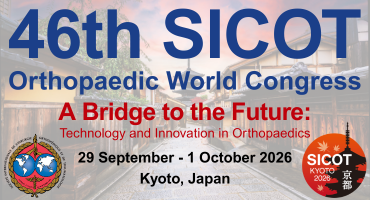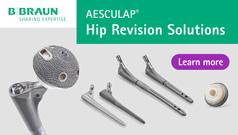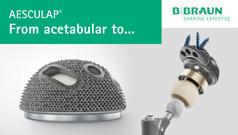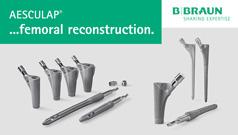Labral debridement versus refixation
Labral debridement
Author: Ahmed Rabie
Assistant lecturer - Fayoum University, Egypt
The labrum is the fibrocartilage triangle that covers the edge of the acetabular fossa. It has many functions but the most important and well approved one is that it maintains a fluid seal around and inside the hip joint. Another proved function is its proprioceptive function. It is now proved that the labrum has pain receptors and this is the most common complaint in patients with labral tears [1].
Arthroscopic labral debridement could be indicated in cases of labral tears with complex and more severe pathology initially and those with labral calcification or ossification as reported by Larson et al. It is now documented that the labral tears are most commonly associated with femoroacetabular impingement, with the pincer and the mixed types being the most common to cause labral fraying and degeneration which is irreparable [2].
To obtain good results, debridement should be restricted to the only diseased part of the labrum and preserving the healthy segments as possible with stable remnant parts and good transitional zone from the debrided and the healthy one [2].
Reviewing the literature, since Altenberg described the open labral debridement in 1977, the arthroscopic techniques and equipments have developed to allow arthroscopic partial resection of labral tears [3].
In 1995, Fitzgerald documented that around 91% of his labral debridement series had significantly improved in a mean follow-up of 53 months [4].
O’Leary et al [5] reported that around 91% of their cases experienced improvement in their mechanical symptoms.
In a study by Santori and Villar that included 58 patients with follow-up of 3.5 years, the patients were asked about their satisfaction after surgery and only 39 (67.3%) reported being 'pleased' with the results of the surgery, whereas 32.7% were not pleased [6].
Byrd and Jones [7] had a long follow-up for their cases of labral debridement and reported that if there was no evidence of preoperative joint arthritis the patient significantly benefited from partial labrectomy. Robertson et al [8] performed a systematic review to determine the patient satisfaction following acetabular labral debridement and concluded that up to 91% of patients were satisfied with their outcome at 3.5 years and a complete resolution of mechanical symptoms was detected in around 50% of patients with this complaint and up to 90% had reduction in their symptoms. McCarthy et al [9] reported in their study that the more the labrum is torn the worse the prognosis of the patient, as 40% of the patients with stage 3 labral tears had good-to-excellent results compared with 91% good-to-excellent results in patients with stage 1 labral lesions.
Farjo et al reported that 21% of the patients with radiographic evidence of arthritis had good results compared with 75% of those who had no arthritis. 43% of the first group had total hip arthroplasty later whereas only 14% of the second group had total hip arthroplasty. Success rates are lower with worsening degrees of labral tear and secondary OA changes [10].
In a recent review article by B. Haddad et al [11], they concluded that it seems more logical to repair an unstable tear with a good quality labrum to preserve its physiological function. On the other hand, debridement is more logical for a degenerative labrum which is the source of discomfort and its preservation may result in persistent pain plus the added risk of failure of repair. They did not support routine refixation for all labral tears.
It is now clear that labral debridement gives better results in dealing with degenerated tears rather than repairing them which may cause persistent pain [12,13].
Labral debridement is an easy procedure which does not consume much time like the repair consumes, so there is a shorter traction time and less neuoropraxias postoperatively. Therefore, labral debridement is an excellent operation but with only the indicated cases. Although, the fluid seal mechanism in the hip joint may be disrupted which may disturb the hip biomechanics. More studies with a long follow-up duration are needed.
References:
- Marc J. Philippon, Lourenço P. Peixoto and Peter Goljan. Acetabular Labral Tears: Debridement, Repair, Reconstruction. Oper Tech Sports Med. 2012; 20:281-286.
- Larson CM, Giveans MR: Arthroscopic debridement versus refixation of the acetabular labrum associated with femoroacetabular impingement. Arthroscopy 2009; 25:369-376.
- Andrew T. Pennock, Marc J. Philippon and Karen K. Briggs. Acetabular Labral Preservation: Surgical Techniques, Indications, and Early Outcomes. Oper Tech Orthop. 2010; 20:217-222.
- Marc R. Safran, MD, and Sanaz Hariri. Hip Arthroscopy Assessment Tools and Outcomes. Oper Tech Orthop. 2010; 20:264-277.
- O’Leary JA, Berend K, Vail TP. The relationship between diagnosis and outcome in arthroscopy of the hip. Arthroscopy 2001; 17:181.
- Santori N, Villar RN. Acetabular labral tears: result of arthroscopic partial limbectomy. Arthroscopy 2000; 16:11–15.
- Byrd JW, Jones KS. Prospective analysis of hip arthroscopy with 10-year followup. Clin Orthop Relat Res 2010; 468:741–746.
- Megan M. Groh ئ Joseph Herrera. A comprehensive review of hip labral tears. Curr Rev Musculoskelet Med. 2009; 2:105–117.
- McCarthy JC, Noble PC, Schuck MR, Wright J, Lee J. The Otto E. Aufranc Award: the role of labral lesions to development of early degenerative hip disease. Clin Orthop Relat Res 2001; 393:25–37.
- Megan MG and Joseph H. A comprehensive review of hip labral tears. Curr Rev Musculoskelet Med 2009; 2:105–117.
- B. Haddad, S. Konan, F. S. Haddad. Debridement versus re-attachment of acetabular labral tears. Bone Joint J 2014; 96-B:24–30.
- Philippon MJ, Briggs KK, Yen YM, Kuppersmith DA. Outcomes following hip arthroscopy for femoroacetabular impingement with associated chondrolabral dysfunction: minimum two-year follow-up. J Bone Joint Surg [Br] 2009; 91-B: 16–23.
- Beaule PE, O’Neill M, Rakhra K. Acetabular labral tears. J Bone Joint Surg [Am] 2009;91-A:701–710.
Labral refixation
Author: Ahmed H. Abdelazeem
Lecturer - Cairo University, Egypt
Many studies were done to understand the exact function of the acetabular labrum [1-5]. Comparing it with the glenoid labrum or the knee meniscus, which are concerned with increasing the joint stability and contact surface area respectively, it appeared that it has a minimal effect. Its hydraulic sealing effect and proprioceptive functions proved to be of utmost importance for a proper hip joint function. Having a triangular cross section and sealing effect at the joint periphery, it maintains the fluid film within the joint, providing an even distribution of contact forces across the articular surfaces and thus preventing articular cartilage degeneration. Also having proprioceptors will add to its protective mechanism for cartilage injury by preventing abnormal motions in the joint [1-4].
In a recent cadaveric study [5] comparing the effect of resection, repair and reconstruction on joint fluid pressurization, the authors concluded that even partial resection has a drastic impact on the fluid pressurization as opposed to its improvement with repair and reconstruction. On the other hand, clinically, several comparative studies showed superior outcomes of refixation over debridement [5].
The first paper pointing to the importance of refixation was in 2003, where Espinosa et al [6] published the preliminary outcomes after a trial of labral refixation using an open approach. They concluded significant better clinical and radiological outcomes both at one and two years follow-up in the labral repair group as compared to the debridement group. Commenting on their excellent outcomes, many authors attributed this to their meticulous technique and using the labral base fixation suture type, thus restoring the normal anatomical labral shape and joint seal. This led to a normal functioning joint and had the best impact on the patient satisfaction.
Since this paper, several arthroscopists started to refix rather than debride the labrum using several techniques [7-16]. Haddad et al [16] in a recent meta-analysis pointed out that although due to heterogeneity of reports he cannot withdraw an accurate decision. They identified five studies in literature comparing arthroscopic refixation versus debridement, four reported higher post-operative scores in the refixation groups. Finally, they stated that 'in general, in the good and excellent results, the debridement group had lower mean satisfaction scores'.
Moreover, in one of the largest series including labral refixation, Philippon et al [7] performed hip arthroscopy for a large scale of cases of femoroacetabular impingement (FAI) and chondrolabral dysfunction and reported that 'labral repair instead of debridement and joint space more than 2 mm are independent predictors of a better outcome'.
Concerning the healing potential of the labrum, although theoretically it has a low healing potential being vascularized from its capsular site in the outer one third, histological specimens proved that the arthroscopically repaired acetabular-labral lesion can heal with fibrovascular repair tissue or direct reattachment via new bone formation. Moreover, several authors have reported that during a second look operation labral healing was detected with no problems [17].
Nowadays, comparison between different types of labral suture types including loop, intra substance and labral base fixation have gained the attention of hip arthroscopists [9]. Regaining the labral seal function using any of the above techniques had proven to give the best outcome.
Although labral debridement carries many advantages including shorter operative time, less traction, etc., it carries the major disadvantage of distortion of the normal sealing function and increasing the articular cartilage stress. There is no doubt that proper labral repair is superior to resection in the proper candidate.
In our opinion, the new and the recent labral refixation techniques will widen the indications of labral repair as well as make it less time consuming and more feasible.
References:
- Konrath GA, Hamel AJ, Olson SA, et al. The role of the acetabular labrum and the transverse acetabular ligament in load transmission in the hip. J Bone Joint Surg Am. 1998;80(12):1781–8.
- Ferguson SJ, Bryant JT, Ganz R, et al. The influence of the acetabular labrum on hip joint cartilage consolidation: a poroelastic finite element model. J Biomech. 2000;33(8):953–60.
- Ferguson SJ, Bryant JT, Ganz R, et al. The acetabular labrum seal: a poroelastic fi nite element model. Clin Biomech. 2000; 15(6):463–8.
- Ferguson SJ, Bryant JT, Ganz R, et al. An in vitro investigation of the acetabular labral seal in hip joint mechanics. J Biomech. 2003;36(2):171–8.
- Marc J. Philippon et al. The hip fluid seal—Part I: the effect of an acetabular labral tear, repair, resection, and reconstruction on hip fluid pressurization. Knee Surg Sports Traumatol Arthrosc 2014; 22:722–729.
- Espinosa N, Rothenfluh DA, Beck M, et al.. Treatment of femoro-acetabular impingement: Preliminary results of labral refixation. J Bone Joint Surg Am 2006; 88:925-935.
- Philippon MJ, Briggs KK, Yen YM, et al. Outcomes following hip arthroscopy for femoroacetabular impingement with associated chondrolabral dysfunction: Minimum two-year follow-up. J Bone Joint Surg Br 2009; 91:16-23.
- Roxanne M. Chow, Christopher J. Owens, et al. Arthroscopic Labral Repair in the Treatment of Femoroacetabular Impingement. Arthroscopy Techniques. 2013; 2:e333-e336
- Ken Ye and Parminder J. Singh. Arthroscopic Labral Repair of the Hip, Using a Through-Labral Double-Stranded Single-Pass Suture Technique. Arthroscopy Techniques. 2014:e1-e5.
- Larson CM and Giveans MR. Arthroscopic debridement versus refixation of the acetabular labrum associated with femoroacetabular impingement. Arthroscopy 2009; 25:369-376.
- Philippon MJ, Weiss DR, et al. Arthroscopic labral repair and treatment of femoroacetabular impingement in professional hockey players. Am J Sports Med 2010; 38:99-104.
- Marc J. Philippon, Scott C. Faucet, et al. Arthroscopic Hip Labral Repair. Arthroscopy Techniques. 2013; 2: e73-e76
- Christian D et al. Hip arthroscopy with labral repair for femoroacetabular impingement: short-term outcomes. Knee Surg Sports Traumatol Arthrosc 2014); 22:744–749.
- Schilders E, Dimitrakopoulou A, Bismil Q, Marchant P, Cooke C. Arthroscopic treatment of labral tears in femoroacetabular impingement: a comparative study of refixation and resection with a minimum two-year follow-up. J Bone Joint Surg [Br] 2011;93-B:1027–1032.
- Megan MG and Joseph H. A comprehensive review of hip labral tears. Curr Rev Musculoskelet Med 2009; 2:105–117.
- B. Haddad, S. Konan, F. S. Haddad. Debridement versus re-attachment of acetabular labral tears. Bone Joint J 2014; 96-B:24–30.
- Leandro Ejinsman and Marc J. Philippon. Arthroscopic Labral Reconstruction in the Hip Using Iliotibial Band Autograft. Oper Tech Sports Med 2011; 19:134-139.

















